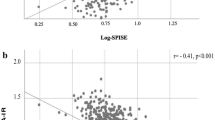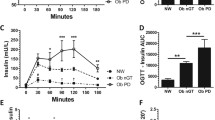Abstract
Most of what is known about the metabolically healthy obese phenomenon is derived from studies in the adult population and no standardized criteria to identify these individuals exist to date. The aim of this study was to determine if the preserved insulin sensitivity evaluated by homeostatic model assessment of insulin resistance (HOMA-IR) index is associated with favorable metabolic profile in the obese children. We studied a group of 248 children and adolescents (150 female, 98 male), aged 5.9–18.9 years with diet-induced obesity (BMI >95th percentile). The entire cohort was divided into quartiles based on levels of insulin resistance determined by HOMA-IR index. Subjects in the lower quartile of HOMA-IR were classified as insulin-sensitive group (ISG), whereas children in the upper quartile were categorized as insulin-resistant group (IRG). The ISG subjects had values of HOMA-IR ≤2.75 while the children from the IRG group had HOMA-IR ≥6.16. Subjects from ISG group had lower basal β-cell activity and were less likely to have impaired fasting glucose or impaired glucose tolerance. Concentrations of LDL and total cholesterol, triglycerides, and transaminases were lower and HDL cholesterol levels were higher in ISG subjects. Findings obtained by the use of Matsuda index correlated well with the findings obtained by the use of HOMA-IR. Conclusion: Lower HOMA-IR values were significantly associated with favorable metabolic profile in studied children, which correlates with findings in the adult population and emphasizes the need for further, longitudinal studies of insulin resistance development in childhood obesity.

Similar content being viewed by others
References
Alberti K (1999) Definition, diagnosis and classification of diabetes mellitus and its complications. Report of a WHO consultation. Diabetes Med 15:S39–S53
Andres R (1980) Effect of obesity on total mortality. Int J Obes 4(4):381–386
Arslanian S (2002) Type 2 diabetes in children: clinical aspects and risk factors. Horm Res 57(Suppl 1):19–28
Bluher M (2010) The distinction of metabolically ‘healthy’ from ‘unhealthy’ obese individuals. Curr Opin Lipidol 21(1):38–43. doi:10.1097/MOL.0b013e3283346ccc
Cali AM, Caprio S (2008) Obesity in children and adolescents. J Clin Endocrinol Metab 93(11 Suppl 1):S31–S36
de Onis M, Onyango AW, Borghi E, Siyam A, Nishida C, Siekmann J (2007) Development of a WHO growth reference for school-aged children and adolescents. Bull World Health Organ 85(9):660–667
Diagnosis and classification of diabetes mellitus (2010) Diabetes Care 33(Suppl 1):S62–S69
Fernandez JR, Redden DT, Pietrobelli A, Allison DB (2004) Waist circumference percentiles in nationally representative samples of African-American, European-American, and Mexican-American children and adolescents. J Pediatr 145(4):439–444
Ferrannini E, Natali A, Bell P, Cavallo-Perin P, Lalic N, Mingrone G (1997) Insulin resistance and hypersecretion in obesity. European Group for the Study of Insulin Resistance (EGIR). J Clin Invest 100(5):1166–1173
Genelhu VA, Celoria BM, Duarte SF, Cabello PH, Francischetti EA (2009) Not all obese subjects of multiethnic origin are at similar risk for developing hypertension and type 2 diabetes. Eur J Intern Med 20(3):289–295
Goran MI, Ball GD, Cruz ML (2003) Obesity and risk of type 2 diabetes and cardiovascular disease in children and adolescents. J Clin Endocrinol Metab 88(4):1417–1427
Karelis AD (2008) Metabolically healthy but obese individuals. Lancet 372(9646):1281–1283
Karelis AD, Rabasa-Lhoret R (2008) Inclusion of C-reactive protein in the identification of metabolically healthy but obese (MHO) individuals. Diabetes Metab 34(2):183–184
Karelis AD, St-Pierre DH, Conus F, Rabasa-Lhoret R, Poehlman ET (2004) Metabolic and body composition factors in subgroups of obesity: what do we know? J Clin Endocrinol Metab 89(6):2569–2575
Karelis AD, Faraj M, Bastard JP, St-Pierre DH, Brochu M, Prud’homme D, Rabasa-Lhoret R (2005) The metabolically healthy but obese individual presents a favorable inflammation profile. J Clin Endocrinol Metab 90(7):4145–4150
Marini MA, Succurro E, Frontoni S, Hribal ML, Andreozzi F, Lauro R, Perticone F, Sesti G (2007) Metabolically healthy but obese women have an intermediate cardiovascular risk profile between healthy nonobese women and obese insulin-resistant women. Diabetes Care 30(8):2145–2147
Marshall WA, Tanner JM (1969) Variations in pattern of pubertal changes in girls. Arch Dis Child 44(235):291–303
Marshall WA, Tanner JM (1970) Variations in the pattern of pubertal changes in boys. Arch Dis Child 45(239):13–23
Matsuda M, DeFronzo RA (1999) Insulin sensitivity indices obtained from oral glucose tolerance testing: comparison with the euglycemic insulin clamp. Diabetes Care 22(9):1462–1470
Matthews DR, Hosker JP, Rudenski AS, Naylor BA, Treacher DF, Turner RC (1985) Homeostasis model assessment: insulin resistance and beta-cell function from fasting plasma glucose and insulin concentrations in man. Diabetologia 28(7):412–419
McLaughlin T, Deng A, Yee G, Lamendola C, Reaven G, Tsao PS, Cushman SW, Sherman A (2010) Inflammation in subcutaneous adipose tissue: relationship to adipose cell size. Diabetologia 53(2):369–377
Meigs JB, Wilson PW, Fox CS, Vasan RS, Nathan DM, Sullivan LM, D’Agostino RB (2006) Body mass index, metabolic syndrome, and risk of type 2 diabetes or cardiovascular disease. J Clin Endocrinol Metab 91(8):2906–2912
Muniyappa R, Lee S, Chen H, Quon MJ (2008) Current approaches for assessing insulin sensitivity and resistance in vivo: advantages, limitations, and appropriate usage. Am J Physiol Endocrinol Metab 294(1):E15–E26
Pinhas-Hamiel O, Lerner-Geva L, Copperman NM, Jacobson MS (2007) Lipid and insulin levels in obese children: changes with age and puberty. Obesity (Silver Spring) 15(11):2825–2831
Primeau V, Coderre L, Karelis AD, Brochu M, Lavoie ME, Messier V, Sladek R, Rabasa-Lhoret R (2011) Characterizing the profile of obese patients who are metabolically healthy. Int J Obes (Lond) 35(7):971–981
Sims EA (1981) Mechanisms of hypertension in the syndromes of obesity. Int J Obes 5(suppl 1):9–18
Sims EA (2001) Are there persons who are obese, but metabolically healthy? Metabolism 50(12):1499–1504
Stefan N, Kantartzis K, Machann J, Schick F, Thamer C, Rittig K, Balletshofer B, Machicao F, Fritsche A, Haring HU (2008) Identification and characterization of metabolically benign obesity in humans. Arch Intern Med 168(15):1609–1616
The fourth report on the diagnosis, evaluation, and treatment of high blood pressure in children and adolescents (2004) Pediatrics 114(2 Suppl):555–576
Tsiros MD, Sinn N, Coates AM, Howe PR, Buckley JD (2008) Treatment of adolescent overweight and obesity. Eur J Pediatr 167(1):9–16
Weiss R, Taksali SE, Dufour S, Yeckel CW, Papademetris X, Cline G, Tamborlane WV, Dziura J, Shulman GI, Caprio S (2005) The “obese insulin-sensitive” adolescent: importance of adiponectin and lipid partitioning. J Clin Endocrinol Metab 90(6):3731–3737
World Health Organization (2009) WHO AnthroPlus for personal computers: Software for assessing growth of the world’s children and adolescents. http://www.who.int/growthref
Zwiauer KF (2000) Prevention and treatment of overweight and obesity in children and adolescents. Eur J Pediatr 159(Suppl 1):S56–S68
Acknowledgments
This study was supported by the Ministry of Education and Science of the Republic of Serbia through project no. 175042, 2011–2014.
Conflict of interest
The authors declare that they have no conflict of interest.
Author information
Authors and Affiliations
Corresponding author
Rights and permissions
About this article
Cite this article
Vukovic, R., Mitrovic, K., Milenkovic, T. et al. Insulin-sensitive obese children display a favorable metabolic profile. Eur J Pediatr 172, 201–206 (2013). https://doi.org/10.1007/s00431-012-1867-5
Received:
Accepted:
Published:
Issue Date:
DOI: https://doi.org/10.1007/s00431-012-1867-5




